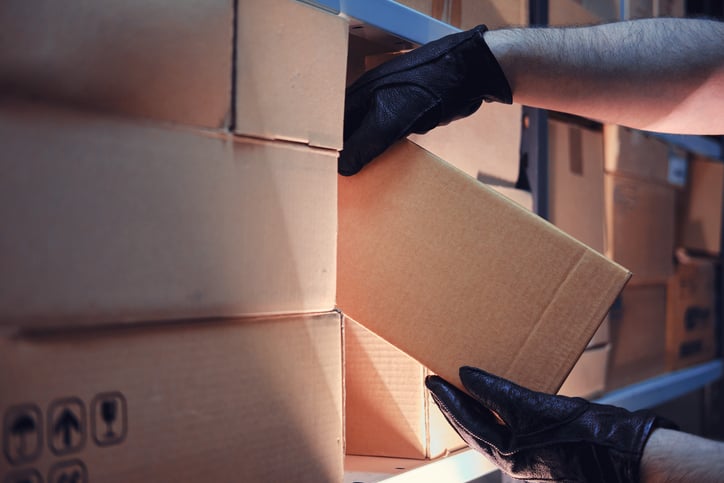Shipping Identity Theft Is a Double-Edged Sword

U.S. cargo theft is a US$35 billion industry, according to the National Insurance Crime Bureau, and during the last two years, pilferage losses have increased exponentially.
“With cargo sitting, local thieves were given the perfect opportunity to snatch product,” said Danny Ramon, intelligence and response manager at Overhaul, during a webinar sponsored by the Ireland-based logistics supply chain risk and security advisory company. “Unfortunately, most companies don’t think they need to increase their security and surveillance systems until after they’ve been hit by heavy losses,” added Overhaul law enforcement liaison John Cannon.
Manufactured materials, goods and the vehicles hauling them are targets in shipping identity theft, a double-edged sword underpinning cargo identity and driver identity.
“Logistics companies under pressure to move product quickly may support cross-docking to minimize warehousing or completely remove it by taking cargo from one transport vehicle directly onto another,” said Ramon. While efficiency may be the goal of this practice, without verification protocols, cross-docking is one of many ways cargo thieves gain access, he said.
Cargo Theft Is an End-to-End Problem
“Theft threats begin even before materials reach manufacturers,” Ramon said. “Depending on where in the world, there can be theft risks in the materials used to make the products or with the products themselves.” He referred to current trends of cargo theft as a “shell game,” occurring through full trailer loads; strategic cargo-, pilferage- and rail-thefts; commercial warehouse burglaries; cross-docking stolen cargo; internet sales of stolen cargo; and use of GPS jammers to avert tracking systems and law enforcement.
“Commercial driver verification is essential to shipment security,” Ramon said. Overhaul conducted a case study illustrating how shipping identity theft can happen. Through technological and field surveillance, the company and law enforcement agencies learned how a California cargo theft crew illegally obtained shipments during transport. They followed a shipment to a truck stop that was part of a route previously hit with theft.
The driver called dispatch to note a fuel stop. He parked the truck in a gated and guarded lot, dropping the trailer there. The driver then took the tractor to an area close by and picked up another individual, and both went back to the truck stop. Overnight, another trailer entered the lot and parked tail-to-tail with the first trailer; cargo was manually transferred to the second trailer.
Another cargo theft incident cited in the case study involved the same truck stop. A load was picked up but the driver on record did not match the driver on the scene. Upon investigation, it was learned that cargo boxes had been opened while decoys were driven for several miles and then ditched, after the cargo was transferred to another trailer.
“Companies need to up their game on staffing and their documentation,” Ramon said. “Take pictures of the trip manifests, cargo inventory, and commercial driver’s licenses of the drivers from the starting point, end delivery and each truck stop in between.” Having a sequence of verification makes it easier to pinpoint where and how theft happened, he added, and from there, to ask for overview surveillance images.
Cargo theft has become more sophisticated. “There are many repeat offenders, local thieves or organized groups known as ‘crews.’ This is just their way of making a living,” Cannon said. “They plan. They strategize. They go through details and make an exit strategy to escape capture. But there are actions that can be taken to make it harder for them.”
Beat Shipping Thieves at Their Own Game
Create an accurate inventory list to check and balance every stop, Ramon suggested, and watch for product going from trailer to trailer. Monitor the dispatcher, dock worker or others who can provide the info to orchestrate a heist, he said. “Members of a crew could legitimately get hired and become the source of the leak. Properly vetting work candidates is everything to shipment security. The same goes for your supply chain contractors and partners,” he said.
“Crew members will typically ‘mark’ cargo to be hit,” said Cannon, “sometimes they use a smear of paint or dirt on the container. But there are steps that can be taken to minimize risk.” To avoid being followed, place multiple tracking devices in the cargo to offset GPS jammers. Law enforcement will work with shipping companies by setting up sting operations and surveillance to make arrests, he said.
Theft is costly for logistics companies, said Ramon. In addition to loss of product, there can be damage to reputation and brand. When there’s a bait and switch, counterfeit product can wind up on the shelves, he said. “Security is reactive, until it becomes necessary to implement,” he cautioned and added that actionable intelligence is important.


